
Editor's note: David Slater has some impressive credentials: a keen climber (up to E6), co-author of the Yorkshire Limestone Guidebook, photos in Yorkshire Gritstone, and wrote a climbing article recently published in OTE about Portugal.
On the photography front, he has won the prestigious BG Wildlife Photographer of the Year (1997), was overall winner of the Canon/BBC Nature Photographer of the Year (1999), shortlisted for the Photography Yearbook last year, has written for and supplied photos to BBC Wildlife magazine, and contributed to some other mags. In short, he knows what it's about. Here's his guide to how you can get there too.
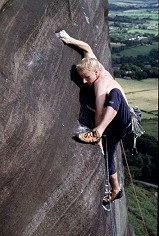
Firstly, do not be put off if you only have an instamatic. You lose control over focusing and exposure, but for climbing pictures it's the subject that counts most. One tip would be to use print film (not slide), scan the print, and manipulate the saturation and contrast to get the best out of the shot.
As to digital cameras - they are great. The quality of digital images can be stunning, equaling that taken with high speed slide film (200ASA+). Digital cameras do have one big advantage - it's cheap to take lots of pictures. One annoyance is the time delay between pressing the shutter and capturing the shot - it's easy to miss a quick expression or move. For the very best shots though, you should use fine grained slides (100ASA or less) and an SLR, especially given that you're almost surely going to lose some quality in a scanning process (or else end up with a huge file that won't be worth putting on the Web).
The Rules of How.
Give it impact. Include the climbers face, either from sideways on or looking down. I like to go to the top of the crag and use a zoom lens resting on the lip of the rock face. This helps to give a sense of steepness. If you have to take a picture from the floor, the trick to avoid making steep rock look slabby is to rotate the camera. For example, for vertical climbs simply line up the rock face or climber's rope with an edge of the viewfinder.
Predict the action. From your experience as a climber you should guess when the climber will make a reach, move a leg up, or move clear of the rock to make a high step. Try to capture facial expressions. Avoid formless bodies and backs of heads.
Include interesting elements of composition such as diagonal features, frames or something unexpected. Overhanging or slabby rock, sideways on, always looks good because it makes a diagonal across the picture. Framing with trees, clouds, shadows etc. help to focus the eye towards the subject as does using diagonal feature such as a sweeping ridge on a mountain. 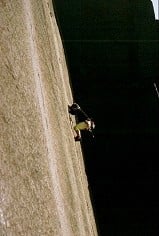
The best photos of all include all of these elements at once, and more besides. They are sharply focused, at least on the eyes of the climber, and well exposed (learn how your camera works). Here's where photography gets complicated. The most frequent mistake with exposure is including too much sky. This makes your camera expose for the bright sky rather than the darker rock. Result is a dark climber. If you don't know how to compensate the exposure for too much sky, a simple rule is to liimit sky to less than a fifth of the frame.
The Rules of When.
Firstly, you'll never take a good picture whilst you're belaying. Detach yourself from the climb. The best photos are often taken on bright days with some shadow. If it's dull, concentrate on close ups rather than the whole climb. Avoid flash unless you know how to get the best out of it, i.e. fill-in flash. The easiest way to get good climbing shots is when bouldering. Here you can choose your angle, get in close if required, get lots of chances to catch the action, and most importantly join in with the climbing yourself.

But there's nothing to stop you taking pictures of strangers or the best climbers yourself. Would you like a stranger to take pictures of you? With a zoom lens they will often not notice you. If they do notice, you may like to ask if its OK, but in my experience they're a friendly bunch who won't mind, providing you keep a low profile and are sensitive to their privacy. Many of the best climbers are used to photographers, and if you look the part, they may even pose for you thinking they'll get in the mags! For example, my picture of Jon Barton was done in his full knowledge yet I didn't ask him (not that he's posing, it actually required this move for the problem!). For the ones of Steve Crowe and Dave Musgove, I asked them if they minded because they were attempting difficult routes. I didn't want them to be distracted by suddenly hearing me clicking away over their shoulders. Be polite.
Lastly, look at lots of examples of pictures that you like. See what makes them work. See if you can find one that doesn't fit in any of my rules. Okay, okay, so there are a few - take a look at the shadow climber - do you like it? Sometimes you CAN break the rules and get away with it! With this in mind, send us your best shots.
Good luck!
David judged the UKClimbing photo competition in July 2001: read the results.

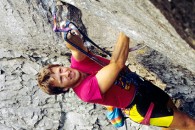

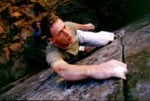
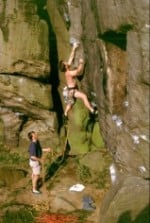


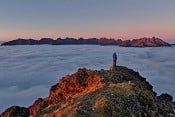








Comments